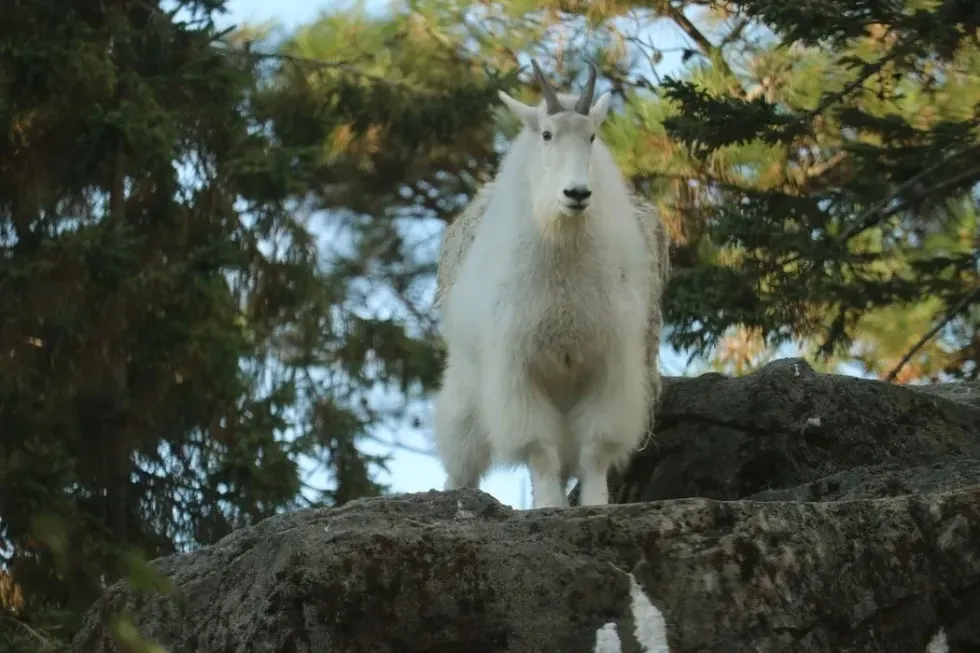Mountain goat (Oreamnos americanus) belong to the goat antelope tribe known as Rupicaprini of the Bovidae family. They may not look like real goats, but they are close relatives of sheep and goats.
They are known to climb steep mountainsides and cliffs with ease due to their muscular legs and broad hooves. Mountain goat (Oreamnos americanus) can climb on snow-covered mountainous terrain or cliffs towards icy peaks comfortably to protect themselves from predators.
North American mountain goats don't butt head like true goats but stab each other with their horns. They can be territorial and aggressive when they are forced to defend their personal space. The North American mountain goats can jump up to 12 ft in one leap.
Let’s have a look at some of the facts about the mountain goat. You may also look at Bactrian Camel and Fennec Fox.
Mountain Goat Interesting Facts
What type of animal is a mountain goat?
The mountain goat (Oreamnos americanus) belongs to the goats and antelope group. They have a close resemblance to goats, sheep, gazelles, and cattle. They are tall, muscular animals with the amazing capability to climb steep mountains, cliffs, and survive harsh climates.
What class of animal does a Mountain Goat belong to?
Mountain goats are mammals. Previously they were found roaming the mountainous region of Northwestern America but many different types of mountain goat are found in many parts of the world. Recently, the mountain goats are found to be domesticated too.
How many mountain goats are there in the world?
Exact figures are difficult to come by for the mountain goats. Mountain goats total count is estimated to at least 100,000 in the North America and Southeast Alaska.
Where does a mountain goat live?
Mountain goats are found in the alpine and subalpine regions of Northwestern America. They are found mostly in high-altitude areas. These days mountain goats are also domesticated and can be found in the farms in these regions.
What is a mountain goat's habitat?
Mountain goats are found in the highest mountains of the Western region of America. They can survive 13,000 feet above sea level too. Mountain goats seasonally migrate to lower level or higher levels within the same region.
Who do mountain goats live with?
The males and the females are very different in their living styles. Adult male mountain goats are mostly solitary in their living style. The females mountain goats live in small groups and could become territorial during the winter months.
How long does a mountain goat live?
The mountain goats live for 12 to 15 years. However, in zoos and domesticated condition, they live for 16-20 years. It is very common to spot a rocky mountain goat living beyond even 20 years of age.
How do they reproduce?
Mountain goats reach maturity by the time they are 30 months old. Their mating season comes in the months of November and December. The males attract the females by making sounds like a baby goat.
Once the mating season ends, the females may drive away from the males from their marked territory. The females give birth to a single baby goat in the late spring after a 180 day gestation period. The females rarely give birth to more than one baby goat.
What is their conservation status?
The mountain goats’ conservation status is Least Concern. There are plenty of mountain goats present in regions like North America, Southeast Alaska, British Columbia.
Mountain Goat Fun Facts
What do mountain goats look like?
The most recognizable feature of a mountain goat is its wooly beard which extends to its throat mane. They have distinctly pointed horns which have yearly growth rings. They have a distinct look of determination on their face and are known as nature’s mountaineers.
How cute are they?
The baby mountain goats are definitely cute. The adult mountain goats have a more serene look on their face. However, they are known to be aggressive animals.
How do they communicate?
The mountain goats communicate by making bleating sounds.
How big is a mountain goat?
Mountain goats are large animals. They are the largest mammals found in the high altitude environment of northwestern America, being 47-70 in for its length, and 39 in tall.
How fast can a mountain goat move?
The mountain goats are known for their agility and speed. They can reach a speed of 10-15 mph for a short distance. When the mountain goats are threatened or alarmed by predators, they will choose the rockiest or steep terrain to escape.
How much does a mountain goat weigh?
The mountain goats weigh 99-309 lb. The females weighs up to 130-200 lb.
What are their male and female names of the species?
The males are called billies. The females are called nannies.
What would you call a baby mountain goat?
The baby mountain goats are called kids.
What do they eat?
The mountain goats spend most of their time grazing. They eat grass, ferns, twigs, mosses and leave for low-growing shrubs and conifers in the high altitude region. The domesticated mountain goats will eat grains, Alfalfa, fruits and vegetables as well.
During summers, they supplement their foods with mineral licks. The mountain goats are known as ruminating animals.
That is, they eat cud, regurgitate and eat again. The mountain goats have difficulty eating as they approach their old age due to the wearing of their teeth. They may starve to death.
Are they dangerous?
The mountain goats are known to be territorial and aggressive. The female mountain goats are especially protective of their kids and territorial too.
The female mountain goats are more likely to fight then males. Mountain goats, once they settle on a favorable cliff, they may chase all the other mountain goats away from there. Mountain goats use their sharp pointy horns to poke in a fight instead of head butting.
During the mating season, the male mountain dogs may fight with other males to mate with a female mountain goat. Mountain goats should hence be adopted as a pet only by experienced individuals.
Would they make a good pet?
The mountain goats are known to be domesticated or kept on farmlands. But they are known to be unfriendly to humans.
Did you know...
The mountain goats are known as nature mountaineers because of their methodical climbing even on snow-covered mountain tops.
The mountain goat shed its coat in the springtime by rubbing itself against rocks and trees. The males shed first and pregnant female mountain goats later in the season.
The males have longer horns and beards as compared to female mountain goats.
The female goats are known to be territorial and more prone to fighting and being aggressive.
The female mountain goats form loose-knit nursery groups of up to 50 animals, whereas the males are solitary animals.
The baby mountain goats weigh 3 kg when they are born and begin to run and climb (trying) within hours of being born.
The mountain goats have hard hooves with flexible pads for traction while climbing on rocky cliffs. They sometimes fight because of their sharp horns. The males have thicker skin which act as armor against attack from rivals and females.
They can excavate plants from a thick sheet of snow too. The mountain goats have black lips, nostrils and hooves. They have a thick white coat of fur so that they can hide in the snow from predators.
The mountain goats' horns don’t shed like the antlers of elk, deer, and moose. The horn continues to grow.
Like the ring of the tree indicates the age of the tree, the same way the rings on the horn let us know the age of the mountain goat.
The mountain goat horns are visible after they turn two years old.
The mountain goats have a concave footpad which acts like a suction cup which helps them to have better footing on steep rocky terrain.
The mountain goats prefer south-facing slopes in the winter, which are warmer.
The large female mountain goats are considered to be highly respected and they always get the best of feeding and sleeping spots in the group. The male mountain goat don't enjoy that much respect until and unless it is the mating season.
The baby mountain goats are known to play a game called king of the hill, where the kids try to push one and another off a high rock. The baby mountain goats learn about their habitat from their mothers and by playing with other kids too.
As the baby mountain goats develop their horns, they start to move away from others.
Is the mountain goat a goat?
The mountain goat is not the same genus as a pure goat. They are more related to antelope, gazelle, and cattle of the bovidae family, even though they share a lot of similarities with sheep and goats.
How has the mountain goat adapted to its habitat?
The mountain goat has a muscular body with strong legs and hooves that are well suited for climbing steep, rocky terrains. The mountain goats have strong shoulder and neck muscles that propel them to climb higher. They prefer to climb to a higher elevation to protect themselves from predators.
Still, they will stay above the treeline. The baby mountain goats are known to start working around rocks after the day they are born. The mother mountain goats are always around when the baby goats are learning.
Here at Kidadl, we have carefully created lots of interesting family-friendly animal facts for everyone to discover! Learn more about some other mammals including giant anteater, or plains zebra.
You can even occupy yourself at home by drawing one on our Mountain goat coloring pages.










